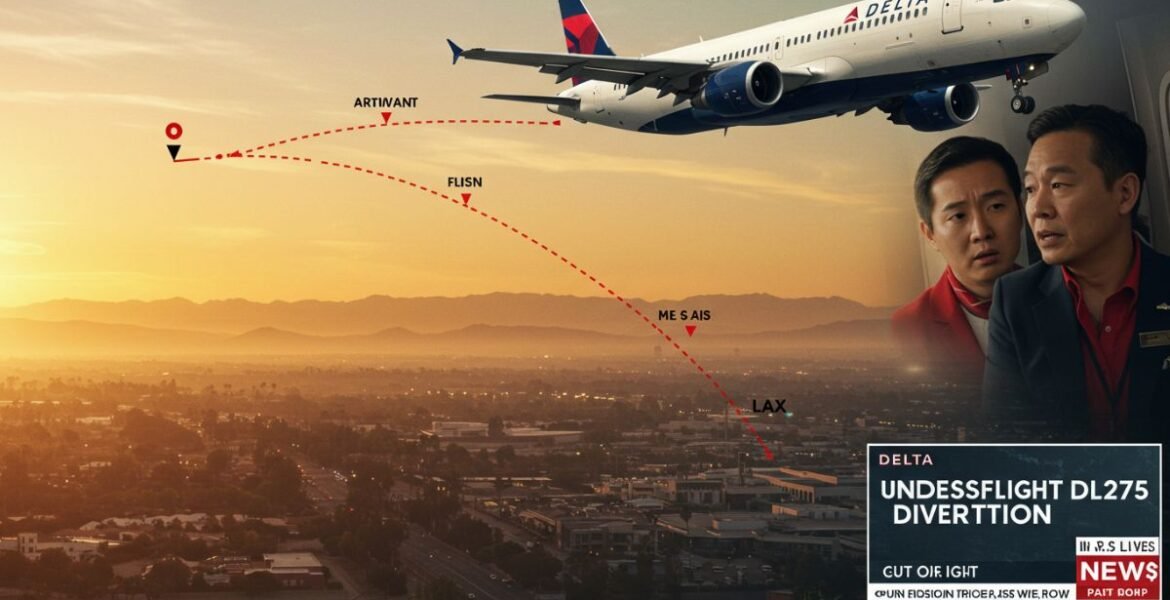When travelers boarded Delta Flight DL275 bound for Seoul-Incheon International Airport, they expected a smooth transpacific journey. However, mid-air turbulence and unexpected circumstances led the aircraft to divert to Los Angeles International Airport (LAX), sparking global curiosity and concern. The event, which unfolded dramatically, revealed not just the challenges of long-haul aviation but also the professionalism of Delta’s crew and safety protocols.
The Incident: A Sudden Mid-Air Diversion
According to official reports, Delta Flight DL275, a Boeing 777-200ER, departed from Detroit Metropolitan Wayne County Airport on schedule. Everything appeared normal until the aircraft experienced an unexpected mechanical warning in its system. Following aviation safety procedures, the flight crew decided to divert to Los Angeles (LAX) as a precautionary measure.
While no injuries were reported, the unscheduled landing created a buzz among passengers and aviation enthusiasts worldwide. Eyewitnesses described the crew’s calm and professional demeanor, assuring everyone on board that safety remained the airline’s top priority.
Why Was LAX Chosen for Diversion?
Many have wondered why LAX was selected instead of other nearby airports. The reason lies in Delta’s operational logistics and Los Angeles’ world-class emergency facilities.
LAX provides advanced technical support, maintenance infrastructure, and ready access to Delta’s engineering teams. In emergency scenarios, these factors make it an ideal choice for safe diversion and technical inspections.
Furthermore, Los Angeles International Airport has one of the largest runways in the United States, capable of accommodating wide-body aircraft like the Boeing 777. This ensures that safety checks and passenger comfort can be maintained with minimal disruption.
Passenger Experience During the Diversion
Passengers aboard Delta Flight DL275 reported that the flight attendants remained calm, providing real-time updates and maintaining order throughout the incident. The pilot communicated clearly, explaining the decision to divert as a “precautionary step.”

Upon landing, Delta’s ground staff at LAX provided immediate assistance, including hotel accommodations, meal vouchers, and flight rebooking options. Such customer service excellence demonstrates why Delta Airlines continues to rank among the top-rated U.S. carriers for passenger satisfaction.
Delta Airlines’ Commitment to Safety
Delta Airlines is known for its stringent safety standards. Every aircraft undergoes routine technical inspections and pre-flight checks to ensure smooth operation. When a potential issue arises, pilots and engineers follow strict FAA-approved protocols to prioritize passenger safety above all else.
In this case, Delta Flight DL275’s diversion highlights how seriously the airline takes preventive measures. Instead of risking a long oceanic route to Seoul, the pilots made a responsible decision to land at LAX, where proper technical evaluation could occur.
Social Media Reactions
As news of the diversion spread, social media platforms like Twitter (X) and Reddit saw hundreds of posts using hashtags such as #DeltaDL275 and #LAXDiversion.
Many users praised the airline’s swift response and transparent communication, while a few expressed concern about potential mechanical faults in long-haul aircraft.
A passenger posted:
“Delta handled the situation perfectly. The crew was calm, professional, and reassuring. We landed safely, and that’s what matters most.”
Such positive reactions further enhanced Delta’s brand reputation during what could have been a PR challenge.
Aviation Experts Weigh In
Aviation analysts explained that in-flight diversions are relatively common and are not necessarily signs of major danger.
According to FAA safety guidelines, diversions occur when pilots detect irregular system behavior, weather issues, or passenger medical emergencies.
Experts agree that Delta’s quick decision to divert DL275 to LAX was “a textbook example of proactive aviation safety.”
Additionally, Boeing 777-200ERs are built with redundant safety systems, meaning any minor warning can trigger alerts even if there’s no immediate threat. Such technology ensures that pilots err on the side of caution.
Aftermath: What Happens After a Diversion
Once the aircraft landed safely at LAX, Delta’s maintenance teams began a detailed inspection of the mechanical system that triggered the warning. Passengers were transferred to another aircraft scheduled to continue to Seoul-Incheon Airport the following morning.
Delta’s customer care team also issued travel credits and compensation options to affected passengers, showcasing the airline’s dedication to customer satisfaction even during unexpected disruptions.
Lessons from Delta Flight DL275’s Diversion
The incident surrounding Delta Flight DL275 serves as an important reminder of the complexity of modern aviation and the uncompromising focus on safety that major airlines maintain.
It highlights the professional decision-making of Delta’s flight crew and the importance of constant communication between pilots, engineers, and air traffic control.
For passengers, it’s reassuring to know that modern aircraft systems are designed to detect even the smallest anomalies and that airlines like Delta take immediate corrective actions.
Conclusion
The diversion of Delta Flight DL275 to LAX wasn’t just a momentary travel disruption—it was a showcase of Delta’s reliability, professionalism, and safety-first mindset.
From the pilot’s decision-making to the ground crew’s support, every step reflected the airline’s commitment to ensuring passengers reach their destinations safely.
As investigations conclude and Delta resumes regular operations, this incident will likely stand as an example of how aviation safety protocols protect lives every day.
Passengers can rest assured that Delta Airlines remains among the world’s most trusted carriers for international travel.



